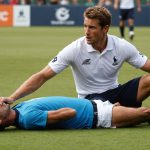Mastering Your Post-Pentathlon Recovery: Top Techniques for Optimal Cooling Down
When you’re an athlete, particularly one involved in demanding sports like pentathlon, your recovery process is just as crucial as your training. Here’s a comprehensive guide to help you master your post-pentathlon recovery, ensuring you’re always ready for the next challenge.
Understanding the Importance of Recovery
Recovery is not just about resting; it’s an active process that helps your body repair and adapt after intense physical activity. For pentathletes, who engage in a variety of disciplines such as fencing, swimming, equestrian, running, and shooting, recovery is vital to maintain high performance.
This might interest you : Essential Hydration Strategies for Marathon Runners Battling Heat: Stay Cool and Thrive!
“Recovery is where the magic happens,” says Coach Jane Smith, a renowned sports coach. “It’s during this time that your body repairs the micro-tears in your muscles, replenishes energy stores, and adapts to the demands you’ve placed on it.”
Immediate Post-Event Cooling Down
The first few minutes after an event are critical for initiating the recovery process. Here’s what you should do:
Topic to read : Ultimate Recovery Strategies for Athletes: Post-Match Essentials After Competitive Polo
Static Stretching
Static stretching helps reduce muscle soreness and improves flexibility. Focus on the major muscle groups used during your event.
- Hamstrings: Stand with your feet shoulder-width apart, then bend forward at the hips to stretch the back of your legs.
- Quadriceps: Stand with one hand against a wall for balance, lift one leg behind you, and grab your ankle with your hand.
- Chest and Shoulders: Stand in a doorway with your hands on the doorframe at shoulder height, then lean forward.
Light Cardio
Engage in light cardio activities like walking or jogging to help your body transition from a high-intensity state to a lower state. This also aids in the removal of waste products from your muscles.
Hydration
Drink plenty of water or a sports drink to replenish lost fluids and electrolytes. Aim for at least 16-20 ounces of fluid for every pound of body weight lost during the event.
Nutrition for Recovery
Proper nutrition is essential for recovery. Here are some key nutrients and foods to include:
Protein
Protein is crucial for muscle repair and rebuilding. Aim for 15-20 grams of protein within 30-60 minutes after your event.
- Examples: Greek yogurt with berries, a protein shake, or a handful of nuts.
- Quote from Decathlon: “Riches en BCAA, créatine, protéines ou glucosamine, ces compléments alimentaires aident à la récupération musculaire”[5].
Carbohydrates
Carbohydrates help replenish glycogen stores. Opt for complex carbs like whole grains, fruits, and vegetables.
- Examples: Whole grain toast with avocado, a bowl of oatmeal with fruits, or a salad with quinoa.
Healthy Fats
Healthy fats support hormone production and overall health.
- Examples: Nuts, seeds, avocados, and olive oil.
Detailed Recovery Techniques
Here are some advanced techniques to enhance your recovery:
Foam Rolling and Self-Myofascial Release
These methods help reduce muscle tension and improve blood flow.
- How to: Use a foam roller to roll out your major muscle groups, focusing on areas that feel tight or sore.
- Example: Roll your IT band, quadriceps, and hamstrings.
Contrast Showers
Alternating between hot and cold water can help reduce inflammation and improve circulation.
- How to: Start with warm water for 2-3 minutes, then switch to cold water for 1 minute. Repeat this cycle 2-3 times.
- Quote from a Sports Medicine Expert: “Contrast showers can really help in reducing muscle soreness and improving recovery time.”
Compression Garments
Compression clothing can help improve blood flow and reduce swelling.
- How to: Wear compression socks, tights, or sleeves for several hours after your event.
- Example: Use compression socks during travel or rest days to aid in recovery.
Sample Recovery Routine
Here’s a sample routine you can follow after a pentathlon event:
Within 30 Minutes Post-Event
- Stretching: Perform static stretches for major muscle groups.
- Hydration: Drink 16-20 ounces of fluid.
- Nutrition: Consume a mix of carbohydrates and protein.
1-2 Hours Post-Event
- Foam Rolling: Roll out your major muscle groups.
- Contrast Showers: Take a contrast shower to reduce inflammation.
- Compression Garments: Wear compression clothing to aid in blood flow.
2-4 Hours Post-Event
- Light Activity: Engage in light cardio or yoga to keep your body moving.
- Meal: Eat a balanced meal with protein, carbohydrates, and healthy fats.
Table: Comparative Recovery Techniques
| Technique | Benefits | How to Implement |
|---|---|---|
| Static Stretching | Reduces muscle soreness, improves flexibility | Focus on major muscle groups like hamstrings, quadriceps, and chest |
| Foam Rolling | Reduces muscle tension, improves blood flow | Use a foam roller on areas that feel tight or sore |
| Contrast Showers | Reduces inflammation, improves circulation | Alternate between hot and cold water for 2-3 cycles |
| Compression Garments | Improves blood flow, reduces swelling | Wear compression clothing for several hours post-event |
| Light Cardio | Aids in the removal of waste products, transitions body to lower state | Engage in walking or jogging for 10-15 minutes |
| Proper Nutrition | Replenishes glycogen stores, supports muscle repair | Consume a mix of carbohydrates and protein within 30-60 minutes post-event |
Practical Insights and Actionable Advice
Listen to Your Body
Recovery is not a one-size-fits-all process. Listen to your body and adjust your routine accordingly.
- Quote from Coach Jane Smith: “If you’re feeling particularly sore or fatigued, it might be a sign that you need to adjust your training or recovery routine.”
Consistency is Key
Consistency in your recovery routine is crucial for optimal results.
- Example: Make recovery a part of your daily routine, just like your training.
Seek Professional Help
If you’re struggling with recovery or experiencing persistent injuries, seek help from a sports medicine professional.
- Quote from a Sports Medicine Expert: “Sometimes, it takes a professional eye to identify what’s going wrong and how to fix it.”
Recovery is an integral part of any athlete’s training regimen, especially for those involved in high-performance sports like pentathlon. By incorporating these techniques into your routine, you can ensure that your body is always ready for the next challenge.
Remember, recovery is not just about resting; it’s about actively helping your body repair and adapt. With the right techniques and a consistent approach, you can master your post-pentathlon recovery and achieve high performance levels.
So, the next time you’re finishing up an event, think about the recovery process as an essential part of your training. It’s your time to help your body heal, adapt, and come back stronger than ever.






